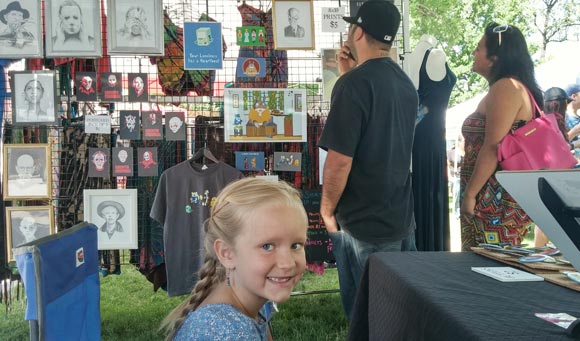A few years ago, my ex-wife and I decided to start a small business, with the comic book and sci-fi convention circuit specifically in mind. Neither of us were happy with our jobs, we’re both creative people who love video games, cartoons, and science fiction, and her parents offered to finance us until we were up and running.
On the advice of a successful business acquaintance, we incorporated in our home state. We had a catchy name, a bunch of clever ideas for merchandise, and ambition and energy to spare. A close friend with a great aesthetic sense volunteered to help us design our booth.
We worked hard, learned a lot, and generally had a great time, but then life caught up with us and we were forced to shelve the project for a while. Now that convention season has rolled around again, I thought it might be helpful to others if I jotted down a few of the things we discovered.
Do Your Basic Homework
You know the saying, “Look before you leap”? Yeah, we didn’t follow it. There’s tons of helpful advice online about how to successfully navigate the convention circuit, and we spent precisely zero seconds reading it. Our products were cool, so we thought they would sell for sure, and that we’d learn everything we needed to know as we went along. Unfortunately, this approach was a little naive.
Be Sure of Your Audience
We had a vague idea of our audience—they were people who liked the same things we did. That wasn’t nearly specific enough. For example, we created a kick-ass T-shirt celebrating the best (don’t argue!) computer game series of all time—Sierra’s King’s Quest. It cost us $800 to execute because of the amount of colors involved, and we just crossed our fingers that there were enough true believers out there to justify the expense. Given enough time and enough conventions, there probably would have been. But we never should have spent that kind of money without at least having an idea of the average age of convention attendees, their budgets, spending patterns, etc.
Invest Wisely
While T-shirts paying tribute to beloved characters like Adventure Time‘s Finn and Jake are very popular, they’re also very expensive to produce unless you can do your own screen printing. My ex and I came up with nine solid T-shirt ideas, and spent around $6,000 to have them printed by a third party.
They looked great, and lots of people loved them. Fans took pictures with their phones and dragged friends over to see them. Problem was, they bought posters, postcards, and buttons featuring the same designs instead.
Make a Business Plan
We should have focused on getting our designs on materials that were inexpensive to produce, and put the rest of the money into advertising, travel, and our website. This might have happened if we’d written a business plan. A business plan forces you to think things through. It helps you set goals, decide whether they’re attainable, and make detailed plans for reaching them. They don’t have to be complicated, and you can change them as you gain experience, but skipping the process altogether was a big mistake.
Don’t Lose Your Cool When Things Go Wrong
The first rule of comic book and sci-fi conventions is that they’re unpredictable. Some are better run and organized than others. The personalities of the management teams are different. At Salt Lake Comic Con, we paid $600 for a prime spot in a high-traffic area, only to get bumped at the last minute in favor of a golf company who’d hired Larry Thomas—the actor who played the Soup Nazi on Seinfeld—as their spokesman. I was livid, with all sorts of litigious fantasies swirling around in my head. Thankfully, my wife talked sense into me and we worked with management until we found a spot that was almost as good, with a couple of amenities thrown in for our inconvenience. It isn’t worth it to burn bridges, even if you’re treated unfairly. (To be honest, if getting one-upped by the Soup Nazi was unfair, it was also awesome.)
Experiment With Your Setup

Our aesthetically gifted friend helped us design an attractive and professional-looking booth, but we were flexible depending on the layout and mood of the venue. For our basic setup, we sat at a table at the back of the booth while our merchandise was displayed on the walls on either side. This usually worked, but there were venues where people seemed hesitant to come in. Sometimes it helped to move the table to the front and rearrange the merchandise so that people could get a general feel for what we had without having to leave the stream of traffic. Be sensitive to the needs of different audiences on different days.
Don’t Stint the Small Stuff
Give business cards, pricing signs, banners, etc., the same loving attention you give your wares. One thing I’m proud of about our maiden run is that everything we produced had a clean, colorful, well-crafted aesthetic meant to assure customers that they weren’t dealing with rank amateurs (even though they were, alas). Our booth was both fun to look at and explore, because everything pleased the eye, and we had a dynamic arrangement of merchandise set at various levels in order to draw people in.
Build an Email List
I found it kind of tough to interact with customers at the beginning. I’m not shy, exactly, but I’d never done sales before. Offering a free pin to people in exchange for signing up for our email list was an easy icebreaker and conversation starter. It didn’t take long to collect hundreds of emails, each one representing a positive exchange with a genuine fan of our booth.
Make Friends With Other Vendors
One of the fastest ways to learn the ins and outs of the convention scene is through chatting with its veterans. These people have been around the block, and have valuable wisdom to share. Get to know them; ask their advice. Buying something from them usually leads to them visiting your booth to reciprocate. Same with sending customers their way.
Make Friends With Management
Try to get on a first-name basis with the management team of every convention you attend. Ask them questions about Wi-Fi, the number of chairs you’ll be allotted, whether there’s free parking for vendors, etc. Be persistent, but patient and respectful at the same time. These are very busy people. They’ll appreciate not having to hold your hand, and if their memories of you are positive they’ll go out of their way to help you at future events.
Think Carefully About Financing
While borrowing money from family or friends is a perfectly valid path to business financing, it’s awkward for at least two reasons. The first is that if your business doesn’t succeed and you find yourself unable to repay your debt, you could ruin a cherished relationship. The second potential drawback is that if your lenders set ridiculously generous terms (as ours did), it doesn’t feel like a business loan as much as a nice gesture from your peeps. You might be tempted to relax more than you would if you used a business credit card or a loan from an online lender.

Be Greedy for Experience
Don’t just go to comic book and sci-fi conventions; try farmers markets, fairs, and every other nerd-friendly venue that’ll let you set up shop. This will give you a general feel for whether being a traveling merchant is a) something you’re good at, b) something you enjoy, and c) something worth committing to before spending gobs of money.

Have Fun
Whatever else you do, decide to create good memories even if you ultimately head in a different direction. Take a lot of pictures, make a lot of friends, and invite family and friends to help out. Hawking goods you’re passionate about in an exciting setting is a once-in-a-lifetime experience. Seriously, how often do you get to watch Deadpool saunter around examining your artwork while you sell a Doctor Who button to an elf?
This article was originally written on July 21, 2016 and updated on November 1, 2016.


Have at it! We'd love to hear from you and encourage a lively discussion among our users. Please help us keep our site clean and protect yourself. Refrain from posting overtly promotional content, and avoid disclosing personal information such as bank account or phone numbers.
Reviews Disclosure: The responses below are not provided or commissioned by the credit card, financing and service companies that appear on this site. Responses have not been reviewed, approved or otherwise endorsed by the credit card, financing and service companies and it is not their responsibility to ensure all posts and/or questions are answered.